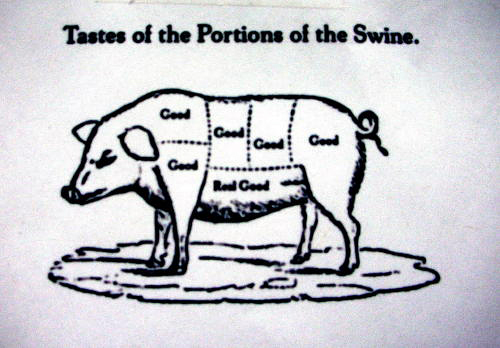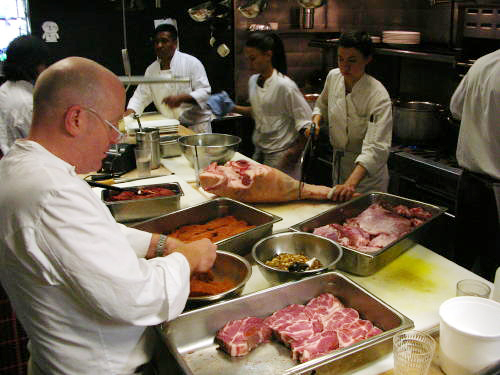
Oliveto Chef Paul Canales seasons pork cutlets while Sous Chef Kelsey Bergstrom cuts into a pork leg with a hand saw.
Yet if you want restaurants to be respectful of the meat they serve, extracting every ounce of flavor and using all parts of the animal, then these scenes shouldn't shock you. Many chefs run a far tidier kitchen by relying on industrial meat processors to do their butchery, delivering meat cuts that are shrink-wrapped and ready to cook.
Oliveto's experiments with whole-hog cookery started more than a decade ago, when the restaurant, under owner Bob Klein and former Executive Chef Paul Bertolli, developed a relationship with Paul Willis and Bill Niman, founders of the Niman Ranch meat company.
Willis, a hog farmer from Iowa, met Niman in the mid-1990s, as industrial hog farming was transforming the landscape of the Midwest and North Carolina. Farmers such as Willis were trying to stay in business by marketing the quality and benefits of the pork that was raised without hormones and antibiotics, with the pigs allowed to range freely. That led to a partnership with Niman and the birth of Niman Ranch.
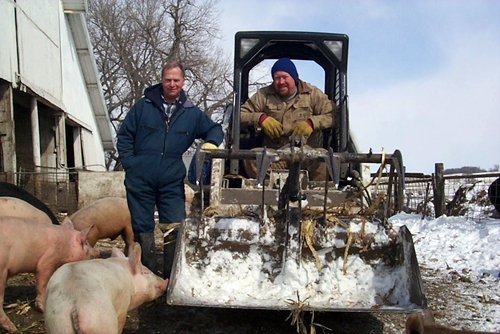
Paul Watson, seen left, heads a network of 500 small farmers who supply pork to Niman Ranch.
Today, Willis supervises a network of 500 farmers who produce pork for more than 1,200 restaurants, ranging from chains such as Chipotle Mexican Grill to high-end restaurants such as Oliveto. His success has inspired many other farmers, including some here in California, to grow their own pigs and market them directly to restaurants.
Every Tuesday at Oliveto, a truck pulls up in the garage of the building, delivering a split carcass pig, usually from Willis. For the last several months it has been my job, along with Oliveto butcher Pablo "Tigre" Mendoza Gavito, to heft and these split carcasses (100 pounds) into the basement meat locker.
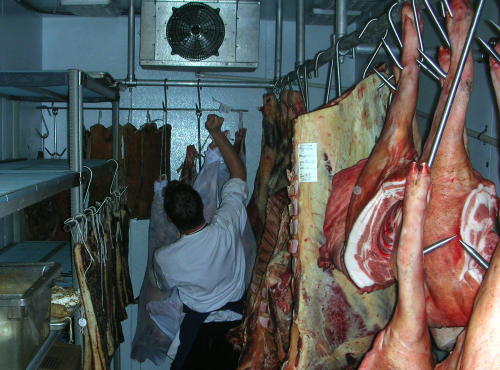
Hanging meat from hooks can be dangerous, as former Oliveto Sous Chef Curtis Di Fede demonstrates.
This can be a dangerous job. Pigs are slippery and tricky to hoist. Usually Tigre would lift from the bottom, using a small meat hook to grab hold of the carcass. My job was to grab the hind leg, attach a meat hook to the trotter, and hang the hooked carcass on the meat locker rod while Tigre hefted it from the bottom.
The first time we attempted this together, I inadvertently left my pinkie finger in between the hook and rod. My finger was nearly crushed as the full weight of the carcass came down on the rod. Luckily, I pulled my pinkie out at the last split second.
Once the pigs are in the locker, the chefs assemble a game plan for breaking them down and preparing dishes. That plan changes weekly, depending on the whims of the chefs and what dishes they haven't recently prepared.
"Technically, you want to use the loins and legs first, since those are most subject to spoilage," says Canales, who replaced Bertolli as executive chef in 2004. "The shoulders will last the longest."
Why do the shoulders last longer? As Canales notes, shoulders and other heavily used muscles tend to have high levels of myoglobin, a protein that causes the red color in meat. Birds such as ducks and pigeons have high levels of myoglobin, because they fly such long distances. As a result, ducks and pigeons resist spoilage in a refrigerator longer than chickens do.
After a hog is delivered, Tigre tends to get the assignment of breaking down the hog into its component pieces. He also can be regularly seen trimming up the loin for one of the restaurant's prized dishes, the spit-roasted porchetta.
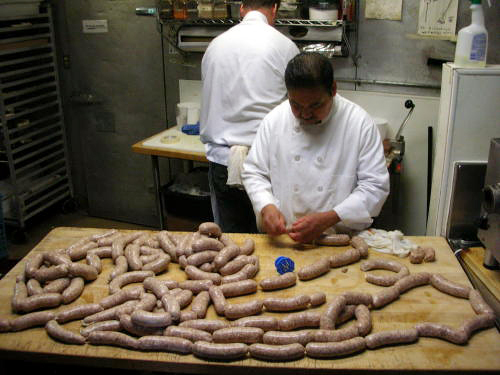
Oliveto butcher Pablo "Tigre" Mendoza Gavito prepares sausage in the back kitchen.
Porchetta is pork rolled with spices and salt into a log and then set on a rotisserie. As it roasts over hot coals, the fat renders out of the meat and keeps it juicy and savory. Slices of this log are then served with an accompaniment, such as a diavolo sauce made with chili peppers.
By contrast, Oliveto generally takes cuts from the leg and turns them into scallopine or salami. Scraps from the leg are ground in a meat grinder and used in a ragu, a pasta sauce. The shoulders, meanwhile, are generally reserved for sausage.
As you can imagine, all this cutting and trimming results in numerous scraps that some butchers might be tempted to throw away. At Oliveto, all these scraps are further trimmed to separate meat from fat. The meat pieces are cooked down into sugo, a heavily reduced pork stock, similar to a demi-glace. The rest might be used for a ciccioli, an intensely rich concoction that is made by cooking down fatty pieces of pork, compressing them and drying them.
Outside of the pigs it breaks down, Oliveto also receives special orders of pork, particularly pork bellies for pancetta. These bellies arrive every other week from Heritage Foods USA, which originated as the online marketing arm for the Slow Food movement. Now a private company, it sells meat from small farmers who are raising and preserving heritage breeds of pigs, turkeys and other animals.
"I try to support them, because they are trying to do the right thing, by these animal and the small farmers," says Canales. "These guys have no outlet. Either they find a niche market, or they get forced out by Tyson or the big outfits."
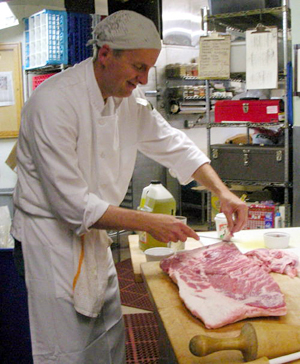
The author trims fat off of a pork belly for pancetta.
While apprenticing at Oliveto, I had a privilege to trim and cure pancetta a few times. It is not terribly hard, as Michael Ruhlman demonstrates in this post. The slabs of pork are seasoned with salt, curing salt and peppercorns, and then hung in cold storage for a week or so.
By the time it is dried, thin sliced and then served, it is belly, belly good. (Sorry, I couldn't resist.)
For Oliveto, the true test of its pork obsession comes in February, with the annual Whole Hog dinners. The menu offers nearly every part of the animal, from the brains down to the trotters. Last year's menu(pdf) featured a wild boar scaloppine alla Milanese, a spaghetti with pork cracklings and a spit-roasted pork belly with Sicilian chestnut honey.
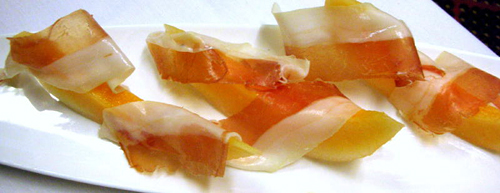
A basic summer dish at Oliveto - cured coppa and melon.
Preparations for these dinners are an all-year affair, since some types of meats - such as prosciutto and coppa - take many months to cure and dry.
I missed this year's Whole Hog Dinner, but plan to be there in February. After six months of trimming, slicing, browning, simmering and curing pork, I feel a closer connection to this noble animal, along with an awareness of how much more there is to learn.
